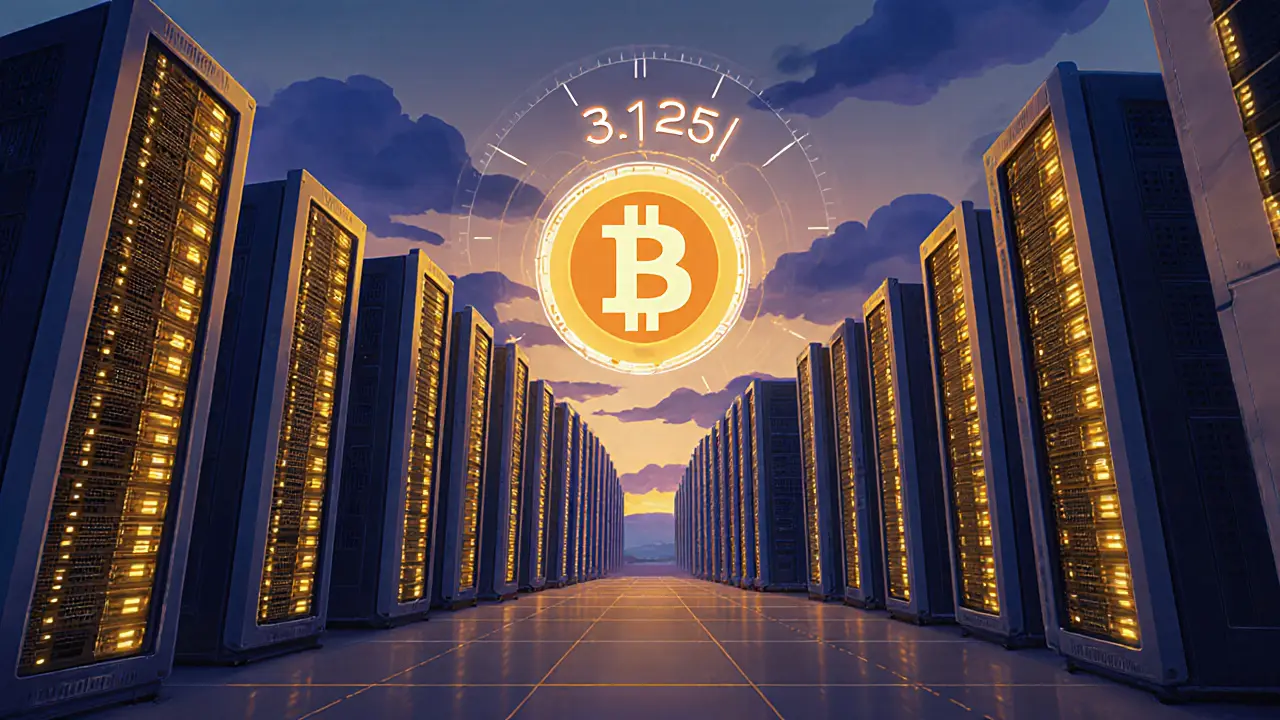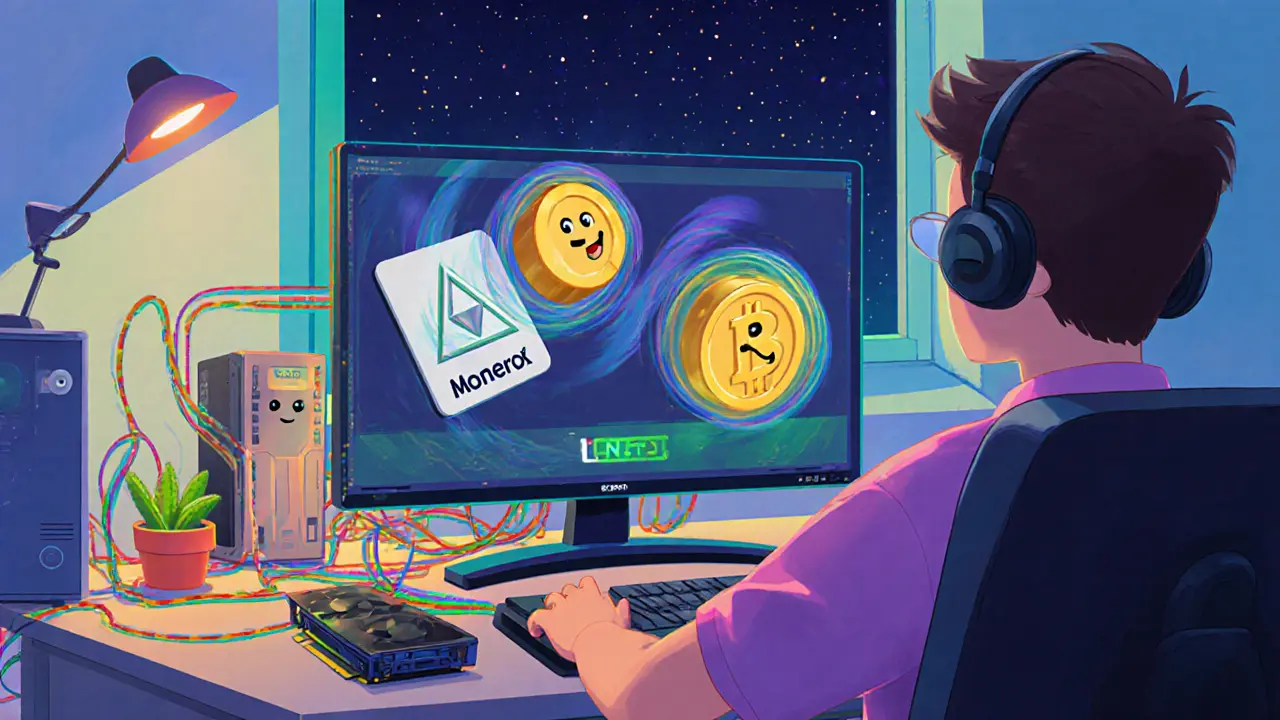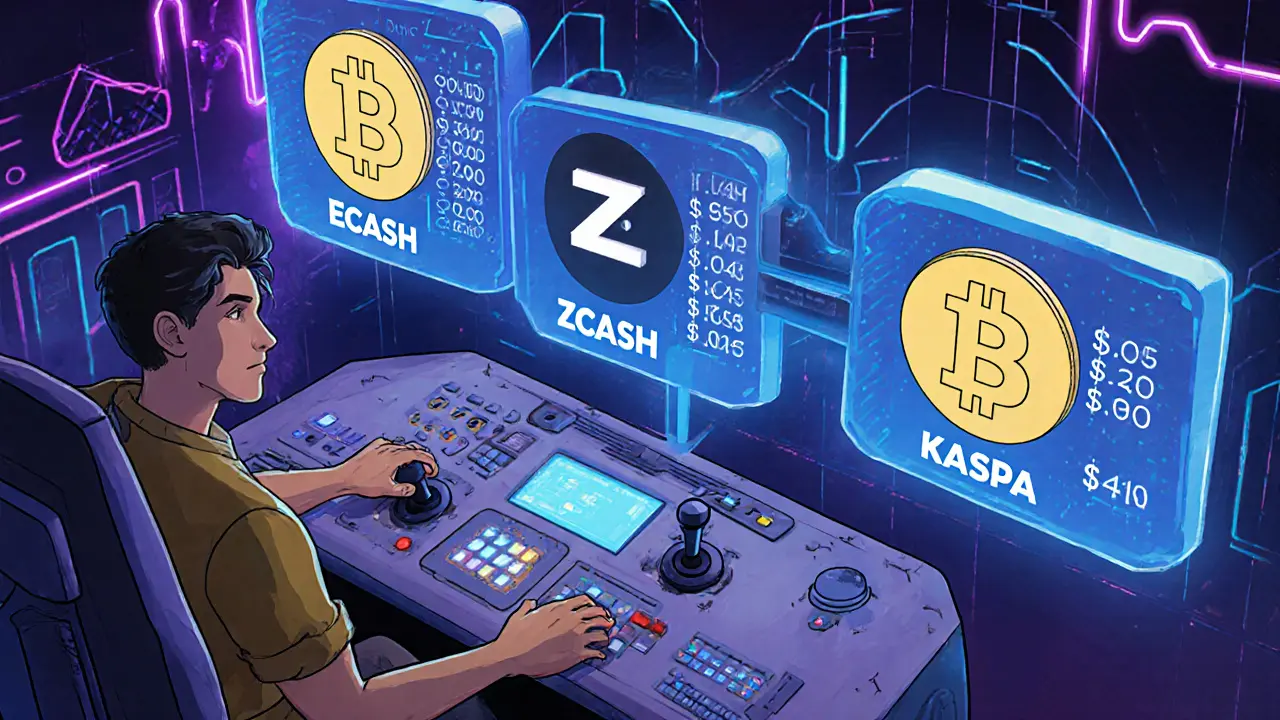 Aug, 23 2025
Aug, 23 2025
Mining Profitability Calculator
Mining Profitability Calculator
Estimated Daily Earnings
Enter your electricity cost and select a blockchain to see your potential daily profit.
Key Takeaways
- Bitcoin’s block reward is now 3.125 BTC and will halve to 1.5625 BTC in 2028.
- ASIC‑resistant chains like Monero and Ravencoin keep mining open to CPUs and GPUs.
- High‑numeric rewards (e.g., ECASH’s 1,812,500 XEC) don’t guarantee profit - price and electricity dominate.
- Transaction fees are becoming a larger part of miner income as block rewards shrink.
- Choosing a chain to mine depends on hardware, electricity cost, and long‑term token outlook.
When you hear the term block reward, you’re looking at the core incentive that keeps a proof‑of‑work blockchain running. Block reward is the predetermined amount of cryptocurrency given to the miner who successfully adds a new block to the ledger. It controls the rate of new token creation and rewards computational work that secures the network.
Since Satoshi Nakamoto introduced Bitcoin in 2009 with a 50 BTC reward, the industry has experimented with countless reward structures. Some chains stick to a simple halving schedule, while others use fixed high‑numeric rewards, dual algorithms, or even daily payout models. The following sections break down the most widely mined blockchains as of October 2025, compare their reward economics, and show how those numbers translate into real‑world profitability.
Bitcoin: The Benchmark Halving Model
Bitcoin (BTC) still defines the baseline for block reward design. After the fourth halving in April 2024, each 10‑minute block yields 3.125 BTC. The reward schedule follows a strict 210,000‑block interval (≈4 years) and will cut again to 1.5625 BTC around 2028. Bitcoin’s SHA‑256 algorithm requires ASIC hardware; the current network difficulty sits above 112 trillion, and the hashrate exceeds 821 exahash per second.
Because the reward shrinks predictably, miners increasingly rely on transaction fees. In 2025, fee income already accounts for roughly 30 % of total miner revenue on average, and that share is projected to rise as block rewards continue to fall.
ASIC‑Resistant Chains: Keeping Mining Open
Not every network wants the barrier that ASICs create. Monero (XMR) uses the RandomX algorithm, which runs efficiently on modern CPUs and GPUs. Its reward sits at 0.6046 XMR per block, generated roughly every 2 minutes. Ravencoin (RVN) employs KAWPOW, another CPU/GPU‑friendly design, offering 2,500 RVN per block every minute.
These chains deliberately avoid ASIC dominance to preserve decentralisation. The trade‑off is lower raw hashpower security per unit of hardware, but the broader miner base can offset that through sheer participant numbers.
High‑Numeric Rewards: ECASH and Others
ECASH (XEC) illustrates a different philosophy: a tiny token value paired with a massive numeric reward-1,812,500 XEC every 10 minutes. The idea is to keep mining attractive even when the token price is low. In practice, profit still hinges on electricity cost and hardware efficiency; miners often earn a similar dollar amount per day as they would on Bitcoin ASICs, but volatility can swing earnings dramatically.
Fractal Bitcoin (FB) takes a hybrid approach, advertising a daily mining income of $26‑27 with lower competition. However, its limited community and scarce documentation make it a niche choice.
Other Notable Blockchains and Their Rewards
Below are additional networks that attract miners for various reasons-speed, privacy, or novel consensus tweaks.
| Blockchain | Reward per Block | Algorithm | Block Time | ASIC / GPU |
|---|---|---|---|---|
| Bitcoin | 3.125 BTC | SHA‑256 | 10 min | ASIC‑only |
| Monero | 0.6046 XMR | RandomX | 2 min | CPU / GPU |
| Litecoin | 6.25 LTC | Scrypt | 2.5 min | ASIC / GPU |
| Dogecoin | 10,000 DOGE | Scrypt | 1 min | ASIC / GPU |
| Zcash | 1.5625 ZEC | Equihash | 75 sec | ASIC / GPU |
| Ethereum Classic | 2.048 ETC | Etchash | 13 sec | GPU (ASIC optional) |
| Kaspa | ≈166 KAS | KHeavyHash | 1 sec | GPU / ASIC |
| Ravencoin | 2,500 RVN | KAWPOW | 1 min | CPU / GPU |
| Grin | 60 GRIN | Cuckatoo32+ / Cuckaroo29 | 1 min | GPU / ASIC |
| Vertcoin | 12.5 VTC | Lyra2RE(v3) | 2.5 min | CPU / GPU |
| Dash | 1.91 DASH | X11 | 2.5 min | GPU / ASIC |
| ECASH | 1,812,500 XEC | SHA‑256 | 10 min | ASIC |
| Fractal Bitcoin | $26‑27 per day (approx.) | SHA‑256 | 10 min | ASIC |

Profitability Checklist for Miners
Before you commit hardware, run through this quick checklist:
- Calculate expected daily revenue using current price and reward amount.
- Factor in electricity cost (e.g., $0.10/kWh for NZ average). High‑reward chains can still be unprofitable if power is pricey.
- Assess hardware availability. ASICs for SHA‑256 are scarce; GPU rigs are easier to source.
- Check network difficulty trends. A rapidly rising difficulty can erode margins within weeks.
- Consider transaction‑fee projections. Chains with low fees may become less attractive after halving.
Choosing the Right Chain: Practical Scenarios
Scenario 1 - Low‑budget hobbyist: You have a gaming PC with a RTX 3080. RandomX (Monero) or KAWPOW (Ravencoin) let you start mining tonight without extra spend.
Scenario 2 - Commercial farm: You own a 1 MW power contract at $0.08/kWh. ASIC‑based Bitcoin or ECASH yields the highest absolute dollar return, despite the higher upfront capex.
Scenario 3 - Diversification strategy: Allocate 40 % of hashpower to Bitcoin, 30 % to a privacy‑focused coin like Zcash, and 30 % to a GPU‑friendly chain such as Kaspa. This spreads risk across price volatility, fee structures, and hardware dependencies.
Future Outlook: Rewards, Halvings, and Beyond
The next Bitcoin halving in 2028 will push the reward down to 1.5625 BTC. Analysts predict fee income will dominate miner earnings shortly after, especially as block size remains limited. Meanwhile, newer PoW projects continue to experiment with reward morphing-some plan to transition to hybrid PoW/PoS models to cut energy use.
For miners, the key is agility: keep an eye on price trends, monitor difficulty rotations, and be ready to switch algorithms if a more profitable chain emerges. Tools like mining profitability calculators and pool fee dashboards make real‑time switching feasible.
What is a block reward and why does it matter?
A block reward is the amount of cryptocurrency a miner receives for adding a new block to a proof‑of‑work blockchain. It creates economic incentive for securing the network and defines the rate at which new tokens enter circulation.

How often does Bitcoin’s block reward halve?
Bitcoin’s reward halves every 210,000 blocks, roughly every four years. The most recent halving was in April 2024, reducing the reward to 3.125 BTC.
Which blockchains are ASIC‑resistant?
Monero (RandomX), Ravencoin (KAWPOW), Vertcoin (Lyra2RE‑v3) and several newer projects like Kaspa use algorithms designed to run efficiently on CPUs or GPUs, keeping mining accessible without specialized ASICs.
Can high‑numeric rewards like ECASH’s be profitable?
Yes, if you have cheap electricity and efficient ASICs. The large number of tokens per block compensates for the low per‑coin price, but volatility can quickly flip profit margins.
How important are transaction fees for miners today?
Fees are becoming a major revenue pillar, especially for Bitcoin where they now make up about 30 % of miner earnings. As block rewards shrink, fees will likely become the dominant source of income.
Hailey M.
August 24, 2025 AT 23:13Mining profits are basically a dance between electricity and hardware 😂
Irish Mae Lariosa
September 3, 2025 AT 05:26While the sarcastic brevity of the previous comment may amuse, let us unpack the reality of high‑numeric reward schemes in a measured, exhaustive fashion. First, the sheer magnitude of tokens per block, such as ECASH's 1,812,500 XEC, creates a false sense of abundance that misleads newcomers; it does not, however, compensate for the intrinsic inefficiencies of hashing power when electricity costs are non‑trivial. Second, the price per token remains minuscule, so the dollar‑denominated revenue curve is still heavily dependent on the hardware's hash‑per‑watt ratio, which, for most ASICs, plateaus near the current efficiency frontier. Third, volatility in market valuation means that today's seemingly lucrative block reward can evaporate overnight, turning what appears to be a profit center into a loss generator. Fourth, the network difficulty adjustment algorithm will respond to influxes of hashpower by climbing, thus eroding any temporary advantage conferred by the inflated token count. Fifth, for GPU‑friendly chains with lower barriers to entry, the opportunity cost of allocating rigs to high‑numeric reward chains is often higher than the marginal gain, especially when one considers the opportunity to mine privacy‑focused or fee‑rich coins. Sixth, the transaction fee component, which is increasingly pivotal across all PoW networks, remains largely unaffected by raw token numbers, and miners ignoring fee dynamics risk under‑performance. Seventh, regulatory scrutiny on mining operations, particularly those involving massive energy consumption, may impose additional externalities that are not captured in reward tables. Eighth, the community support and developer activity around a chain like ECASH are comparatively thin, limiting long‑term sustainability and potential for protocol upgrades. Ninth, the liquidity of the token on major exchanges influences the ability to convert mined coins into fiat, and low‑liquidity assets can incur substantial slippage costs. Tenth, mining pool fees, which are often a fixed percentage, will eat into already thin margins on low‑price tokens. Eleventh, the environmental narrative surrounding high‑numeric reward chains, which often rely on older, less efficient hardware, may deter socially conscious investors. Twelfth, the opportunity for hardware resale value is compromised when mining predominantly low‑price assets, as the equipment may become obsolete before a break‑even point is reached. Thirteenth, the risk of a chain undergoing a hard fork or an algorithmic change is non‑negligible, potentially nullifying mining setups overnight. Fourteenth, the statistical variance in block discovery can lead to erratic daily earnings, making budgeting and forecasting a challenge. Finally, while the headline figures of token per block may capture attention, the underlying economics demand a comprehensive, data‑driven analysis that balances power costs, hardware depreciation, market dynamics, and fee structures before committing capital.
Matthew Theuma
September 12, 2025 AT 11:40It's fascinating how the incentive structures shape miner behavior; when rewards shrink, the fee market gains prominence, and that subtly nudges the ecosystem toward more efficient transaction processing.
From a philosophical standpoint, miners become opportunistic stewards of security, adapting constantly to price signals and difficulty curves.
Carolyn Pritchett
September 21, 2025 AT 17:53Honestly, anyone still arguing that ASICs are "the only way" is living in the stone age; the data shows GPU farms are outpacing them in profitability on several chains, and that's the harsh truth.
Cecilia Cecilia
October 1, 2025 AT 00:06Mining decisions should factor in electricity rates and hardware depreciation, as these elements directly impact net returns.
Devi Jaga
October 10, 2025 AT 06:20Sure, the mainstream narrative loves to hype ASIC dominance, but let's get real: the marginal utility of adding more SHA‑256 rigs diminishes fast, especially when you consider the escalating difficulty and the opportunity cost of not diversifying into GPU‑friendly assets like Monero or Ravencoin, which actually provide a healthier risk‑adjusted return profile in many regions with moderate electricity costs.
Vinoth Raja
October 19, 2025 AT 12:33Looking ahead, the upcoming Bitcoin halving will tighten block rewards, making fee capture a crucial revenue stream; miners should therefore monitor mempool congestion and prioritize chains with robust fee markets to stay afloat.
Kaitlyn Zimmerman
October 28, 2025 AT 17:46For newcomers, a practical tip is to start with a modest GPU setup, test Monero and Ravencoin profitability calculators, and only scale up once you have a clear picture of your local electricity costs and pool fees.
Chris Morano
November 7, 2025 AT 00:00That's solid advice; staying patient and monitoring the numbers will save a lot of headaches later.
Ikenna Okonkwo
November 13, 2025 AT 22:40In sum, the best mining strategy blends hardware efficiency, electricity economics, and a keen eye on fee dynamics; adaptability remains the cornerstone of long‑term success.